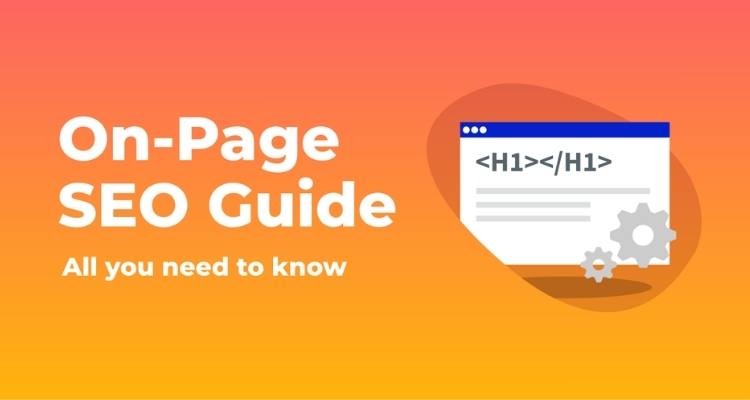If you have a website or an online business, you must already be aware of the importance of SEO. You might even have some idea about the basics because you know that some SEO knowledge is important to make your website rank in search engines.
But the thing is there’s a lot more to SEO than just the basics and in order to rank on google search results, you must enhance your website accordingly.
Today we’ll discuss On-Page SEO, from what it is to how to do on-page optimization so that you may amplify your efforts to see the best results.
What is On-Page SEO?
On-page SEO is the procedure of optimizing web page content to rank higher on search engines and attract more traffic.
On-page SEO refers to optimizing title tags, internal links, URLs, and content of your website.
It is different from off-page SEO, which optimizes for signals that happen off your website (i.e., backlinks).
Why is On-Page SEO so important?
On-page SEO is essential because it helps search engines learn about and recognize your website so they can provide users with the search results most relevant to their queries. It consists of all the SEO factors that are up to you to manage the best. If you own a website, having on-page SEO knowledge can help you regulate technical problems and the quality of your content.
By putting efforts into on-page SEO strategies, you’ll notice a boost in your website’s traffic along with the site’s search visibility.
The Optimization of On-Page SEO
Now that you realize the importance of on-page SEO, it’s time to learn how to do it and what are the parameters you need to take care of.
In the world of search engines, every element on a webpage has its specific name. And search engine bots scan each of these elements to check whether they’re up to the par. This helps them decide if your page is worthy of being displayed on the first page against queries of users.
Below a list of all the important on-page SEO elements with information on how to optimize them.
Title Tags and Headers
Title tag/Header tag is an HTML tag that defines or gives context to the topic of your webpage. It exists on the head section of a webpage. It is highlighted eminently in the SERPs (the blue clickable link that appears in search results).
The main header tag is referred to as H1 and is injected in the main <h1> heading, and each additional heading is used to include a new sub-topic. Here, the <h2> is more well-defined than the <h1>, and the <h3> tags are more precise than the <h2>.
You can think of <h1> and <h2> tags as headings and subheads within your content.
According to Google, you don’t have to use a header tag to rank; you can just rank fine with or without a header tag. With that said, people sometimes overlook the potential of the title tag. It helps Google understand the context of the page, just like it allows users. That’s why misleading, and poorly written title tags can all have a negative influence on your SEO results. So you always need to make sure you’re optimizing this element.
To do that make sure your title is very close to the keywords you are targeting. Your keyword doesn’t always necessarily have to be in your title, and sometimes it doesn’t make sense that way, so in that case, you can use the phrase closest to that keyword.
Meta Description
Meta description plays a crucial role in deciding the search engine ranking of your page. Meta descriptions or meta tags is the description of what the page is about. It is provided underneath the title in the SERPs (Search Engine Results Pages).
The best practice is to write a keyword enriched meta description but at the same time keep is engaging and readable for real humans. A good meta description can help your results stand out, improving your organic CTR (Click-through rate) and impression of the quality of your page.
Internal Links
Link building isn’t only about just external sites linking to your website. You can do it the other way too. Internal linking is a very underrated factor when it comes to On-Page SEO. Internal links help crawlers explore your site, explore new content, and understand the context of various pages.
Every internal linking approach is varied, but for promising results, you ought to make sure that every fresh post or page has at least two or three links to other pages of your site on it. With internal link building, you pass link justification to other pages on your site and help visitors navigate your site.
Alt Tags and Image Optimization
Keywords also apply to images. If you use images on your site, you must also use good keywords for images and alt tags. This helps users understand the contents of the image and also assists search engines in locating relevant images for their image search based on the keywords specified.
When adding images to your site, remember to compress them. Oversized multimedia can reduce your page loading speed.
Approaching Keywords
Keywords are the most crucial part of SEO. They are like the cement that holds it together. Keywords must be researched and selected carefully. As popular or common keywords are way too competitive, instead of targeting them you can work around and target specific or long phrased keywords. That way you’ll get the right audience of people who are especially searching for the services you have to provide.
Make sure to use your targeted keyword in the first 100 words as Google puts its primary attention to what shows up on your page early-on.
Also it is important to note that targeting a specific keyword on multiple pages across your site can cause drastic measures such as keyword cannibalism. You should monitor your site regularly to avoid such oversights.
How To Conduct An On-Page Site Audit
So, these were all the on-page elements that you need to optimize for better ranking in search engines. After implementing them, you’d want to check if your site is completely optimized for the SERPs. In order to do that, you’d need to conduct an on-page SEO audit of your site.
There are a lot of tools that help you do this, the one we’d be using in our demonstration will be Ubersuggest’s SEO Analyzer .
Ubersuggest lets you complete a comprehensive site audit of up to 150 pages for free, unveiling all the errors and explaining how to fix them. Here’s how to do it:
First, open Ubersuggest and Enter your website’s URL and click “Search”.

Here you’ll see a complete overview of your website that shows you things such as, your site’s monthly traffic, number of backlinks, domain score, and the number of organic keywords you are targeting.

Click on the “Site Audit” section on the left sidebar. Ubersuggest will conduct a complete site audit and show you what needs fixing.

It will first show you your On-Page SEO score which ranges from 0 to 100 and tell you where your website ranks in terms of SEO on your website.
Then you will see four sections that are there to review these are:
- Health check: Health of the pages on your website.
- Critical errors: Issues that have the biggest impact on your SEO performance and can hurt a page’s worth to rank.
- Warnings: Less impactful problems but worth fixing.
- Recommendations: These are little bonus steps that you can take to improve your overall SEO performance.
Other than that, Ubersuggest gives you an advanced breakdown that explains why your site might not be loading quickly.

Page loading speed matters as much as your every other approach towards SEO. Slow loading pages have a bounce rate of as high as 47 percent, which means users find it frustrating when a page takes time to load and Google knows that which is why they overrule slow loading pages from their top search rankings.
In the end, you will see a section of Top SEO issues.

This is the final segment of the site audit, and it describes the top On-Page SEO problems. You can click on each line for more valuable knowledge. It’s up to you to decide if it’s something that needs changing or you can leave it untouched.
Wrapping Things Up
So, there you have it. These were all the steps you need to take to optimize your On-Page SEO. hopefully this information will benefit your website in the coming future and make your business grow. Don’t forget to leave a comment below and let us know if you found this guide useful.

